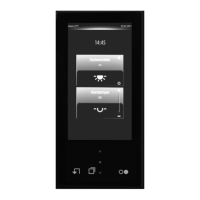Art. No. SC 1000 KNX
4.2.4.2.13 Alarm signal
The device permits signalling of a alarm which might be, for instance, a burglar or a fire alarm
from a KNX/EIB central alarm unit. An alarm is signalled by all status LEDs of the push-button
extension module flashing synchronously. Consequently, the alarm signalling display is only
available when a push-button extension module is connected to the device.
The alarm signalling can be enabled with the parameter "Alarm signalling display" on the
parameter page "Push-button extension module -> Alarm signalling".
When alarm signalling is enabled, the ETS displays the communication object "B.Alarm
signalling" and further alarm function parameters. The alarm signalling object is used as an
input for activating or deactivating alarm signal displaying. The polarity of the object can be
selected. When the object value corresponds to the "Alarm" condition, all status LEDs of the
extension module are always flashing with a frequency of approx. 2 Hz. If there is an alarm, the
behaviour of the status LED for normal operation as configured in the ETS has no significance.
The LEDs adopt their originally configured behaviour only after the alarm signalling function has
been deactivated. Changes of the state of the LEDs during an alarm - if they are controlled by
separate LED objects or if they signal push-button functions - are internally stored and
recovered at the end of the alarm.
Apart from the possibility of deactivating an alarm signal via the alarm object, it can also be
deactivated locally on the device by pressing any button on the extension module. The "Reset
alarm signalling by a button-press?" parameter defines the button response during an alarm…
- If this parameter is set to "Yes", active alarm signal displaying can be deactivated by a
button-press on the push-button extension module. This button-press does not cause the
configured function of the pressed button to be executed. Only after then next button-press
will the configuration of the button be evaluated and a telegram be transmitted to the bus, if
applicable.
- If "No" has been selected, alarm signalling can only be deactivated via the alarm signalling
object. A button-press will always directly execute the configured button function.
If alarm signalling can be deactivated by a button-press, the parameter "Acknowledge alarm
signalling by" defines whether an additional alarm acknowledge telegram is to be transmitted to
the bus via the separate object "B.Alarm signalling acknowledge" after triggering by this button-
press.
Such an acknowledge telegram can, for instance, be sent via a 'listening' group address to the
"Alarm signalling" objects of other bus devices in order to reset the alarm status there as well.
Attention must be paid during resetting of an alarm to the selectable polarity of the acknowledge
object.
i Notes on the polarity of the alarm object: If the setting is "Alarm when OFF and alarm reset
when ON", the alarm object must be actively written by the bus with "0" to activate the
alarm after a reset or after programming with the ETS.
i An active alarm message is not stored so that the alarm indication is generally deactivated
after a device reset or after programming with the ETS.
Page 166 of 347
Software "Smart Control 501511"
Functional description

